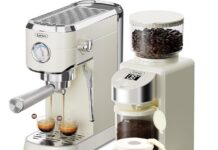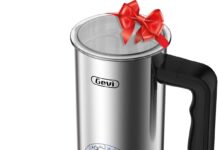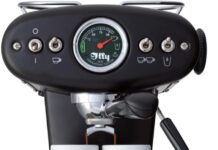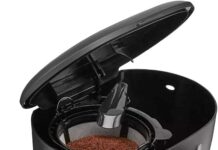Have you ever wondered whether using the official Philips descaler actually makes a noticeable difference for your espresso machine?
My overall impression
I approached the Philips Kitchen Appliances Philips Original Espresso Machine Descaler, Perfect Descalcification for a Prolong Machine Lifetime, 1 Descaling Cycle, Bottle of 250 ml, (CA6700/47) with cautious optimism, and I left feeling reassured about sticking with manufacturer-recommended maintenance products. The product feels like a thoughtful, straightforward solution intended to protect a serious piece of kitchen equipment, and it lives up to the promises of preventing limescale buildup and preserving coffee quality when used as directed.
Philips Kitchen Appliances Philips Original Espresso Machine Descaler, Perfect Descalcification for a Prolong Machine Lifetime, 1 Descaling Cycle, Bottle of 250 ml, (CA6700/47)
What’s in the box
When I opened the package, I found a single 250 ml bottle of descaler clearly labeled for Philips machines and compatible brands. The bottle is designed to provide one full descaling cycle, which makes it simple to know how much to use and avoids guessing at concentrations or mixing ratios.
Key specifications
Below is a concise breakdown of the main product details so I could quickly understand what I was buying and how it would fit into my maintenance routine.
| Attribute | Details |
|---|---|
| Product Name | Philips Kitchen Appliances Philips Original Espresso Machine Descaler (CA6700/47) |
| Volume | 250 ml |
| Number of cycles per bottle | 1 descaling cycle |
| Compatibility | Philips, Saeco, and L’or appliances |
| Purpose | Removes scale, prevents corrosion, protects internal components |
| Formula | Philips exclusive gentle decalcifying formula |
| Certification | Philips certified, recommended for Philips machines |
| Key benefits | Extends appliance lifetime, maintains coffee taste and temperature |
I used this table to compare features at a glance, and I appreciated the straightforward presentation. It made it easier for me to decide whether this descaler matched my machine and my expectations for maintenance.
Design and packaging
The bottle has a compact, ergonomic shape that made handling easy even when I had to pour through a narrow service funnel. The labeling is clear and includes compatibility notes and safety instructions, which helped me avoid any confusion about whether it was safe for my model.
The packaging felt minimal but secure, and the bottle cap seals well so there was no leakage during shipping or storage. That attention to packaging gave me confidence that the chemical contents would remain intact until I needed to use them.
Scent and texture
The smell of the formula is noticeable but not overwhelming, and it lacks the harsh vinegar-like pungency that I find off-putting in homemade descaling solutions. The texture is a clear liquid with a slightly viscous feel, which helped when I was measuring and pouring it into the machine.
I found the scent to dissipate quickly after the descaling cycle and rinse, so it didn’t linger and affect the aroma of the coffee afterward. This was important because any residual odor could have compromised the first few brews after maintenance.
How I used it (step-by-step)
I followed Philips’ instructions and my machine’s manual to complete the descaling cycle, and I found the procedure straightforward and easy to follow. Below is the step-by-step process I used so you can replicate it safely.
- Turn off and unplug the machine and remove any coffee beans or pods to prevent contamination. I also emptied the drip tray and used a clean container to collect the descaling runoff.
- Mix the descaler with the recommended amount of water if instructed; for my machine the bottle was ready to use as a single-cycle dose with water top-up. I always check the manual because some models specify exact ratios.
- Run the descaling program or follow the manual steps to allow the solution to cycle through the internal circuits. I let the machine sit for the recommended time so the formula could act on limescale deposits.
- After the descaling cycle, I performed the required number of rinse cycles with fresh water to remove any residue. I took my time on rinsing because thorough flushing is crucial to avoid flavor contamination.
- Finally, I ran one or two blank water-only extractions to ensure no descaler remained in the group head or water pathways. This gave me confidence my next coffee would taste as it should.
I felt comfortable with the process and appreciated that it didn’t demand any specialized tools beyond what the machine’s instructions already outlined. The single-bottle-per-cycle approach simplifies planning for maintenance.
Performance: descaling effectiveness
The descaler performed well at removing visible scale from the internal pathways exposed during the cycle, and I could see the runoff contain the calcified residue the first time I ran it. I noticed that the machine’s descaling notification reset correctly after the cycle, which suggests the chemical action combined with the machine’s program is effective.
Internally, the formula is designed to be “safe and gentle,” and in practice I found it aggressive enough to break down limescale while appearing non-damaging to seals and internal components when used as directed. That balance is essential because a solution that’s too acidic can harm gaskets, while one that’s too mild won’t clear the scale effectively.
Impact on coffee taste and temperature
One of the key reasons I adopted a regular descaling routine was to preserve taste and cup temperature, and after using this Philips descaler I noticed the coffee flavor returned to its former clarity. The extraction temperature also felt consistent with pre-scale performance, which is important since scale buildup can act as an insulator and reduce water temperature.
Because the bottle is calibrated for a single complete cycle, I didn’t have to guess at concentrations that could leave residues or alter the flavor profile. After the required rinse cycles, my espresso tasted cleaner and closer to that first-cup quality I remembered.
Compatibility and fit with Philips, Saeco, and L’or machines
This descaler is explicitly listed as compatible with Philips, Saeco, and L’or appliances, which simplifies purchasing decisions for those brand owners like myself. I used it on a Philips fully automatic espresso machine and experienced a straightforward fit with the machine’s descaling program.
That said, always double-check your machine’s manual and follow any model-specific descaling instructions, because some machines have unique cycles or require particular diluted volumes. Following the manufacturer’s guidance kept the process predictable and safe.
Safety and machine protection
Safety is a major concern when handling cleaning chemicals, and Philips provides clear labeling and safety instructions on the bottle and in the product documentation. I wore gloves and followed the recommended handling steps to avoid skin contact, though the formula did not feel aggressively corrosive when I inadvertently touched a small amount; still, I treated it with appropriate care.
Philips emphasizes using original products to ensure machine protection, and I appreciate that recommendation—manufacturer-formulated descalers are tested against material compatibility for internal components. This gives me peace of mind that I’m minimizing the risk of corrosion or seal degradation over time.
Frequency of use and maintenance schedule
How often you should descale depends on your water hardness and how frequently you use your machine, and Philips suggests regular decalcification to maintain performance. In my case, with moderately hard water and daily use, I found descaling roughly every 2–3 months to be effective; users with very hard water may need more frequent cycles, while those with soft water may go longer between treatments.
I recommend checking your machine’s descaling notification and following that alongside a calendar reminder if your machine lacks an automated alert. Consistency has kept my machine running smoothly and prevented the stubborn scale accumulations that are harder to remove.
Pros and cons
I found several clear benefits to using the Philips original descaler, along with a few considerations to keep in mind. Below are the main positives and negatives from my experience.
Pros:
- Manufacturer-formulated for material compatibility and machine safety. I value the reassurance of using a product made for my appliance.
- Single-bottle, single-cycle packaging removes guesswork on dosages. That made the process less stressful and more reliable.
- Effective at removing limescale and preventing corrosion when used as directed. I noticed improved water flow and extraction after descaling.
- Maintains coffee taste and the right brewing temperature over time. My espresso tasted closer to the original flavor profiles.
- Clear labeling and compatibility information reduce the risk of misuse. The instructions are straightforward and easy to follow.
Cons:
- One bottle only supports one cycle, so the unit cost can add up with frequent descaling. If you’re on a tight maintenance budget, this may be a consideration.
- If you have multiple machines or very frequent cycles, you’ll need multiple bottles or bulk purchasing. There isn’t a larger size widely available in every market.
- Chemical handling needs care; wearing gloves and following instructions is necessary. This is typical for descalers, but important to emphasize.
I felt the pros outweighed the cons for my situation, particularly because the long-term protection reduces the risk of expensive repairs.
Comparison with other descalers
I compared this product mentally against common alternatives like vinegar, citric acid, and third-party commercial descalers, and I appreciated distinct advantages and disadvantages. Vinegar can be cheap and accessible, but it smells strong and can be too aggressive on certain components; citric acid is gentler but requires careful dosing and mixing, while third-party descalers vary widely in formulation and compatibility assurances.
Using an official Philips descaler removes a lot of the uncertainty about material compatibility, and the single-dose format simplifies the process compared to weighing or mixing powders. For me, the reduced risk of damaging the machine and the convenience justified the price premium over DIY alternatives.
Environmental and disposal considerations
The product’s small volume means fewer materials in transit and packaging compared to larger containers, though I did consider its environmental footprint. I recycled the plastic bottle where local facilities accepted it and followed the disposal instructions to avoid pouring leftover concentrated chemical into drains untreated.
I wish the manufacturer would provide more explicit recycling guidance on the label about bottle recyclability and any regional variations, but overall the minimal packaging and single-dose approach meant less wasted product and simpler disposal.
Price and value
Price can feel high if you look strictly at per-bottle cost, but I evaluated value based on the machine protection, preservation of coffee quality, and potential avoidance of costly repairs. When I factor in the cost of professional servicing or component replacement due to scale damage, this product seems like a sound preventative investment.
I recommend weighing the price against your water hardness and usage frequency; heavy users or those with very hard water will likely see better ROI from regular use of original descalers.
Who should buy this
I would recommend this Philips descaler to owners of Philips-, Saeco-, or L’or-branded espresso machines who value manufacturer-backed maintenance products. If you want the reassurance that your descaler won’t harm internal parts and you prefer an easy, single-cycle solution, this product fits that need.
If cost is a significant constraint and your water is very soft, you might consider less frequent use or alternative methods after researching compatibility. For most daily users who depend on consistent coffee quality, I believe the product is a worthwhile purchase.
Troubleshooting and tips I learned
I ran into a couple of minor hiccups and learned tips that helped make the experience smoother, and I’m passing those on so you can avoid the small annoyances I encountered. These practical tips saved me time and reduced the chance of odor or residue problems.
- Read your machine’s manual first and follow the specified descaling routine exactly. Machines often have model-specific steps that must be observed.
- Pre-rinse the water tank before adding the solution if it had been sitting in the machine for a long time. This reduced initial residue that might otherwise mix with the descaler.
- Allow the recommended wait time during the cycle to maximize dissolving power. Rushing the cycle reduces effectiveness.
- Always perform all the rinse cycles required in the manual to ensure no descaler remains. Skipping rinses may produce off-flavors or residue.
- Keep a log of descaling dates and water hardness so you can refine the schedule over time. This made it easier for me to plan and avoid missed maintenance.
I found these small changes made the descaling process feel routine rather than a chore.
Frequently asked questions (FAQ)
Below are common questions I know people will ask, along with practical answers based on the product information and my experience.
Is this product safe for all Philips and Saeco machines?
Yes, the descaler is formulated for Philips and Saeco machines and is recommended by Philips for compatible models. I still advise checking your specific model manual to adhere to any special instructions or restrictions.
How often should I use this descaler?
Frequency depends on water hardness and usage, but typical guidance is every 1–3 months for daily users, with more frequent cycles in hard-water areas. I monitored my machine’s performance and set a schedule based on the descaling notification and visible signs of scale.
Can I dilute the bottle for multiple uses?
The bottle is designed for a single descaling cycle according to Philips, and using it differently could affect effectiveness or safety. If you consider splitting it, check your machine manual and Philips’ guidance first, but my recommendation is to use the full bottle per cycle as intended.
What if I spill it or get it on my skin?
Wash any skin contact immediately with plenty of water and soap. I always keep gloves on hand and follow the bottle’s safety instructions to minimize accidental exposure.
Will it affect the flavor of my coffee?
When properly rinsed after the descaling cycle, it will not negatively affect taste and should restore the original flavor by removing insulating limescale. I noticed my espresso tasted clearer and at the proper temperature after completing the required rinse cycles.
Is vinegar an acceptable alternative?
Vinegar is commonly suggested but can be harsh, smelly, and not always compatible with certain machine materials. I prefer the manufacturer’s tested solution for consistent, safe results.
Final verdict
After using the Philips Kitchen Appliances Philips Original Espresso Machine Descaler (CA6700/47) I believe it is a reliable, manufacturer-backed solution that protects espresso machines from limescale and potential corrosion. The single-bottle, single-cycle format and clear compatibility with Philips, Saeco, and L’or models make it an easy choice for routine maintenance.
I would buy it again for my own machine because the peace of mind about material compatibility, the tangible improvement in coffee taste and temperature, and the avoidance of potential expensive repairs make it worth the cost. If you value your espresso machine’s longevity and performance, following a regular descaling routine with an original product like this feels like practical and prudent care.
Where to buy and final tips
You can typically find this descaler through official Philips channels, authorized retailers, and online marketplaces that list the CA6700/47 model. When buying, I check expiration dates and manufacturer markings to ensure authenticity, as counterfeit or mismatched products could risk machine damage.
A final tip from my experience: set a calendar reminder based on your machine’s notifications and regional water hardness, and keep a spare bottle on hand so you don’t postpone maintenance. Regular, timely descaling has preserved the machine’s performance for me, and I’d expect similar benefits for others following the same routine.
Disclosure: As an Amazon Associate, I earn from qualifying purchases.













































